Shirazi salad is a healthy, refreshing, and delish Persian cucumber salad that you can make in just 15 minutes. This quick and easy cold chopped salad showcases fresh vegetables, herbs, and a bright citrus vinaigrette. Serve it chilled for the perfect side dish or light meal on its own or to pair with meats such as kebabs.
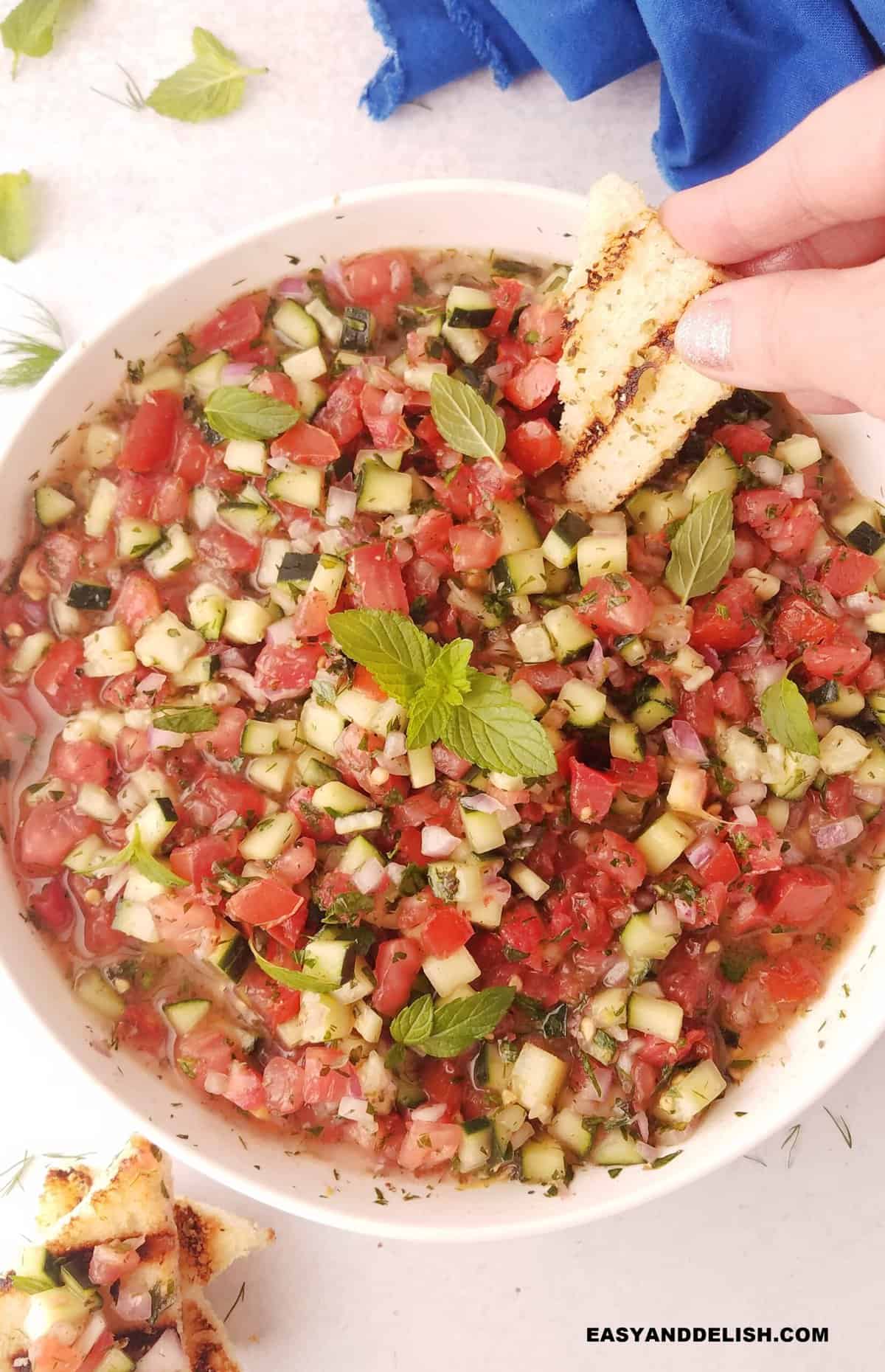
Love a good salad?
Make this quick and super refreshing healthy chopped salad and serve it as a side, as a topping for toast, or as a dip.
It is a must for summer!
Table of Contents
Why you'll love this Shirazi salad recipe
- Quick & easy: This salad comes together in just a few minutes, making it perfect for busy weekdays or evenings.
- Healthy: Packed with fresh vegetables and herbs, Shirazi salad is a nutritious choice for any meal.
- Versatile: Serve Persian cucumber salad as a side dish, a light lunch, or with added protein for a hearty and complete meal.
- Packed with flavor: The lime dressing, herbs, and sumac create a light, tangy, and aromatic blend of flavors you won’t be able to get enough of!
What is Shirazi salad?
Shirazi salad, also called Salad-e Shirazi, is a traditional Southern Iranian dish from the city of Shiraz. It's popularly enjoyed throughout the Middle East, and it’s known for its vibrant colors and refreshing taste.
This simple salad is made by combining finely chopped cucumbers, tomatoes, and onions with fresh herbs like mint. Everything is tied together beautifully with a zesty lime juice vinaigrette and sumac. This unique spice helps make the salad stand out, adding a pleasant tang.
Once tossed, Shirazi salad delivers crisp textures, bright colors, and a perfect balance of flavors. It’s best served chilled and enjoyed during summertime or alongside spicy foods.
Ingredients and substitutions
To make this Persian cucumber salad, you'll need:
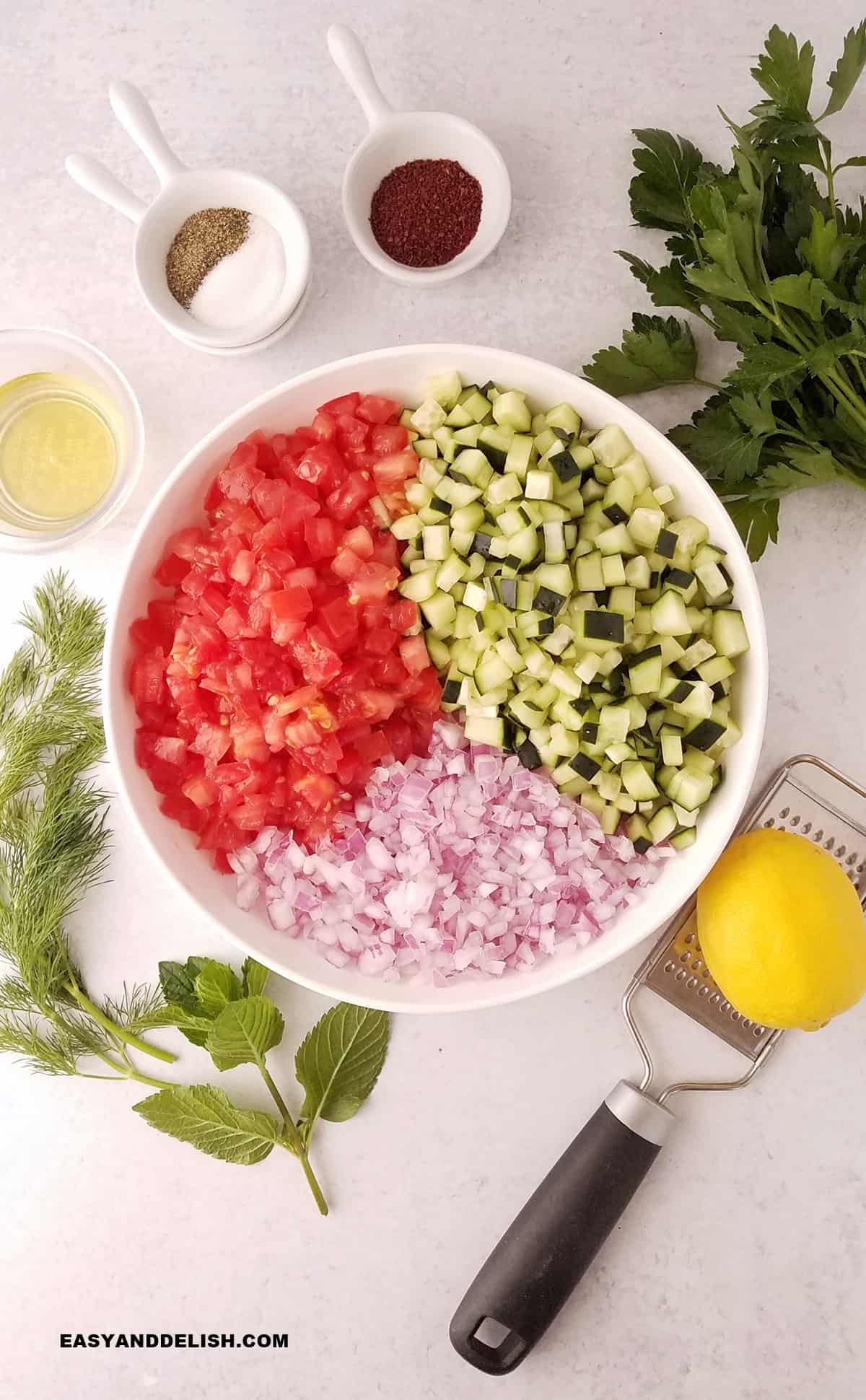
- 4 Roma tomatoes, small diced (if not removing the seeds, place the chunks in a colander for about 5 minutes to release excess juices. But if you have 5- minutes to spare, I recommend you remove the seeds!) - You can use cherry tomatoes as an alternative but make sure to small-dice them.
- 1 English cucumber (or 4 small Persian cucumbers), small diced (no need to peel)- Field cucumbers will work in a pinch, but make sure to peel and seed them.
- ½ cup finely chopped red onions (or yellow onions if you prefer)
- 3 tablespoon EACH chopped fresh parsley, mint, and dill - Fresh cilantro can be used as well.
- Salt and pepper, to taste
- 1 teaspoon sumac, or more to taste (optional) - Alternatively, use lemon zest, lemon pepper, coriander, or za’atar.
- 4 tablespoon fresh lemon juice - Lime juice can be used as a substitute and gives this salad a better tangy taste.
- 3 tbsp extra virgin olive oil - You can also try avocado oil or another mild-flavored oil.
How to make Shirazi salad
1. Prep all the ingredients! Then, place the diced tomatoes, cucumbers, and onions into a large bowl.
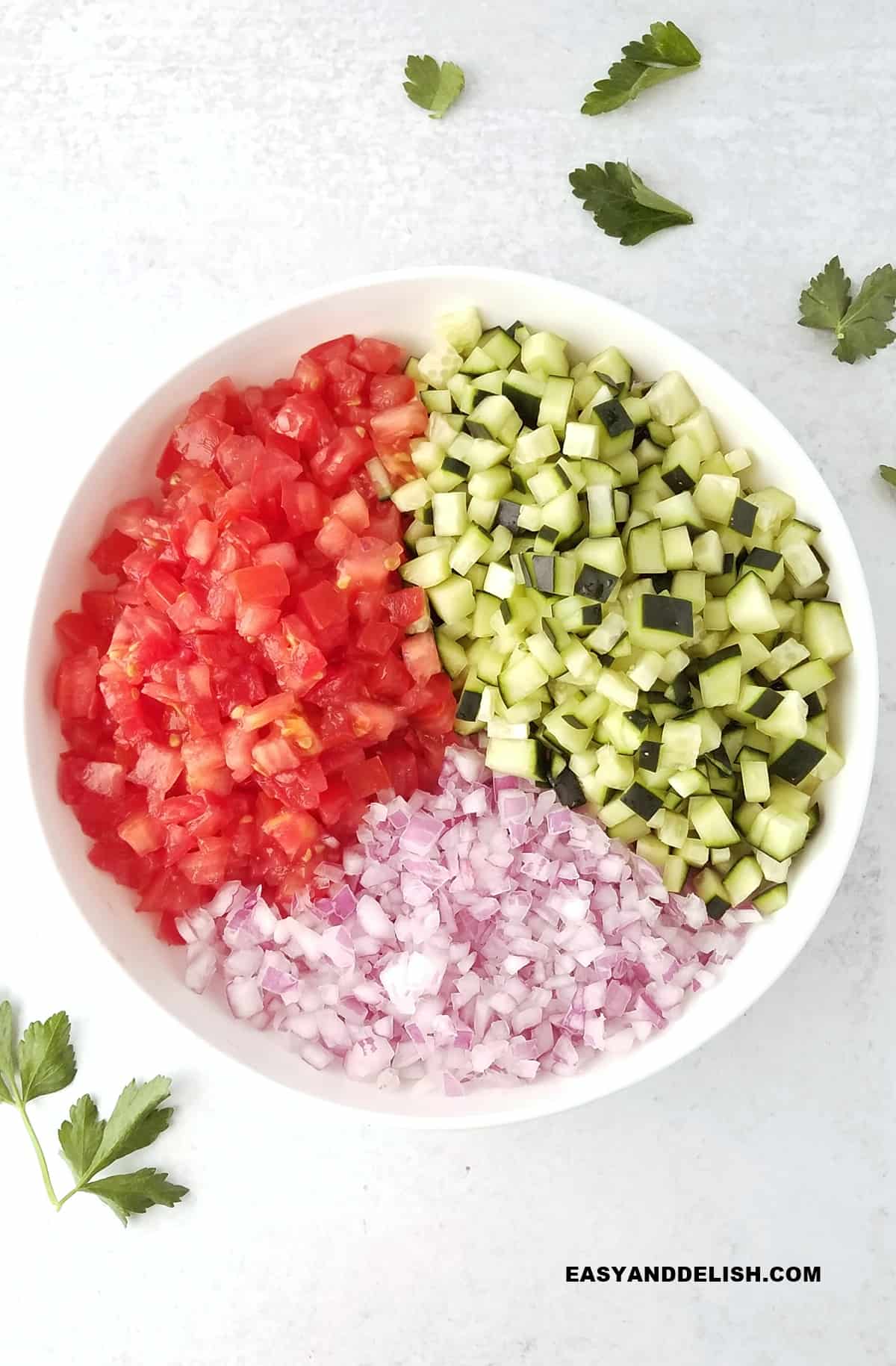
2. Next, add the fresh herbs, and a good pinch of salt and pepper to the veggie mixture. Add sumac!
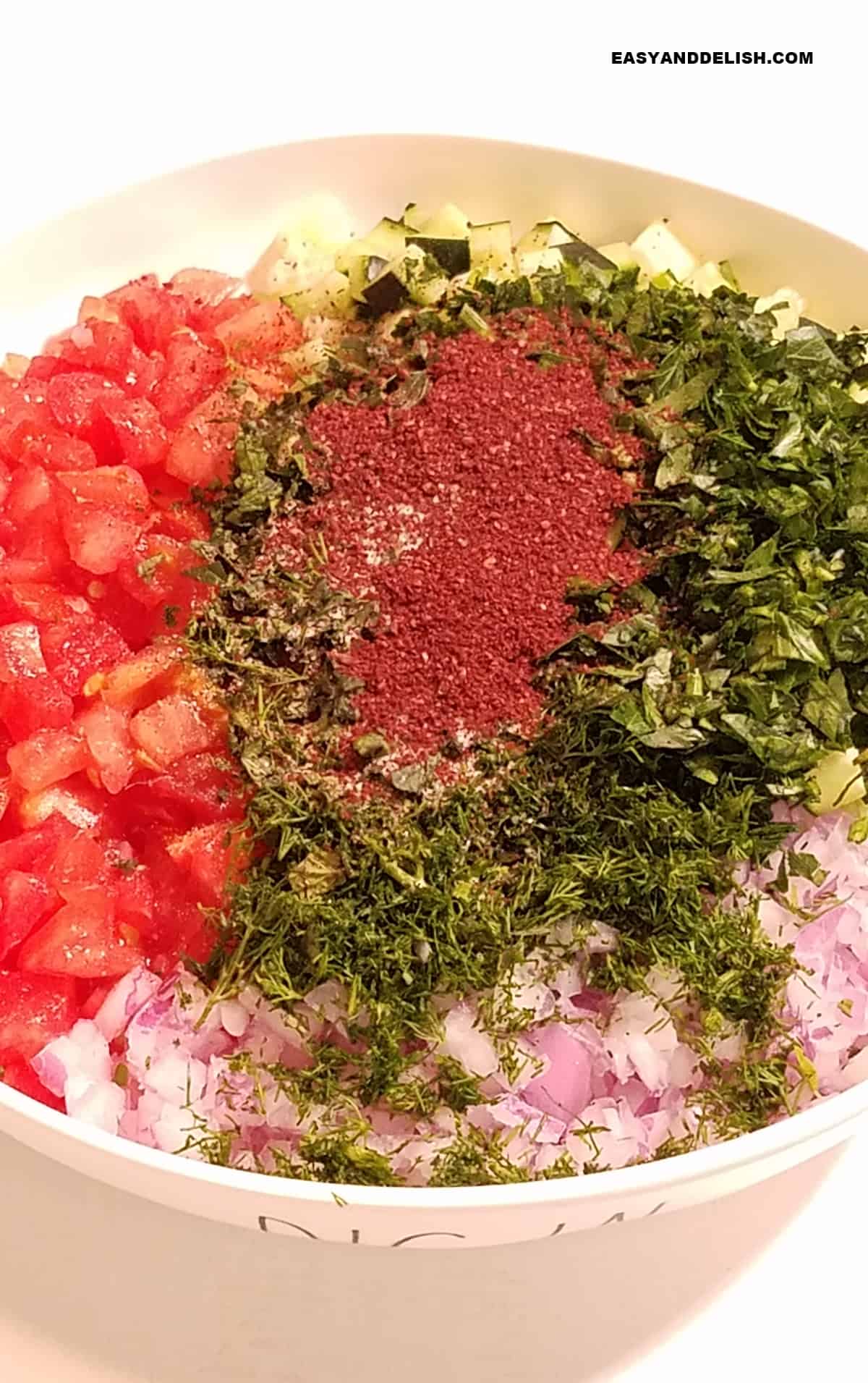
3. Then, add the lime juice and zest.
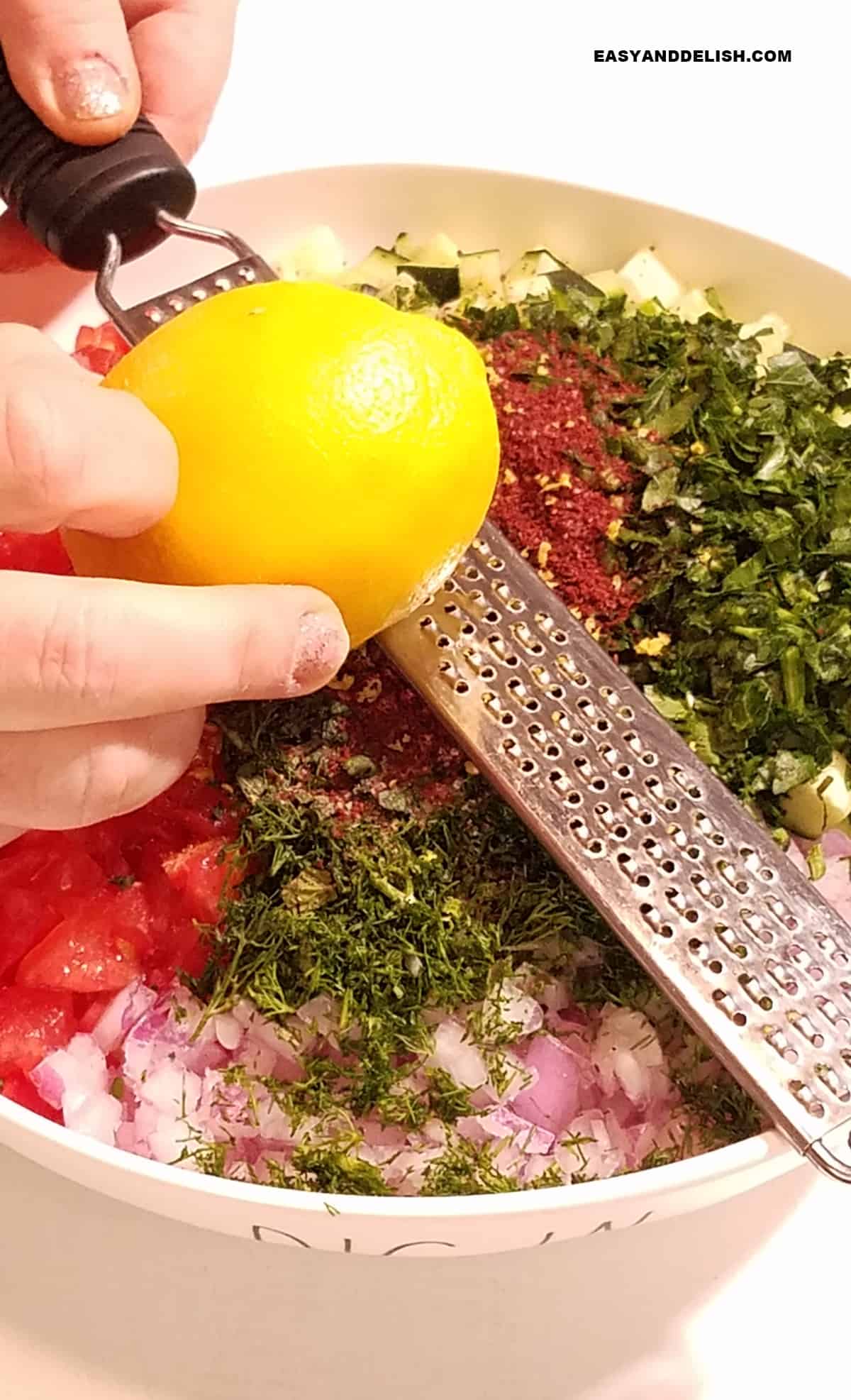
4. Lastly, pour in the EVOO, tossing everything together to combine. TIP: For a crunchier texture, only add lime juice and EVOO about 15 minutes before serving the salad.
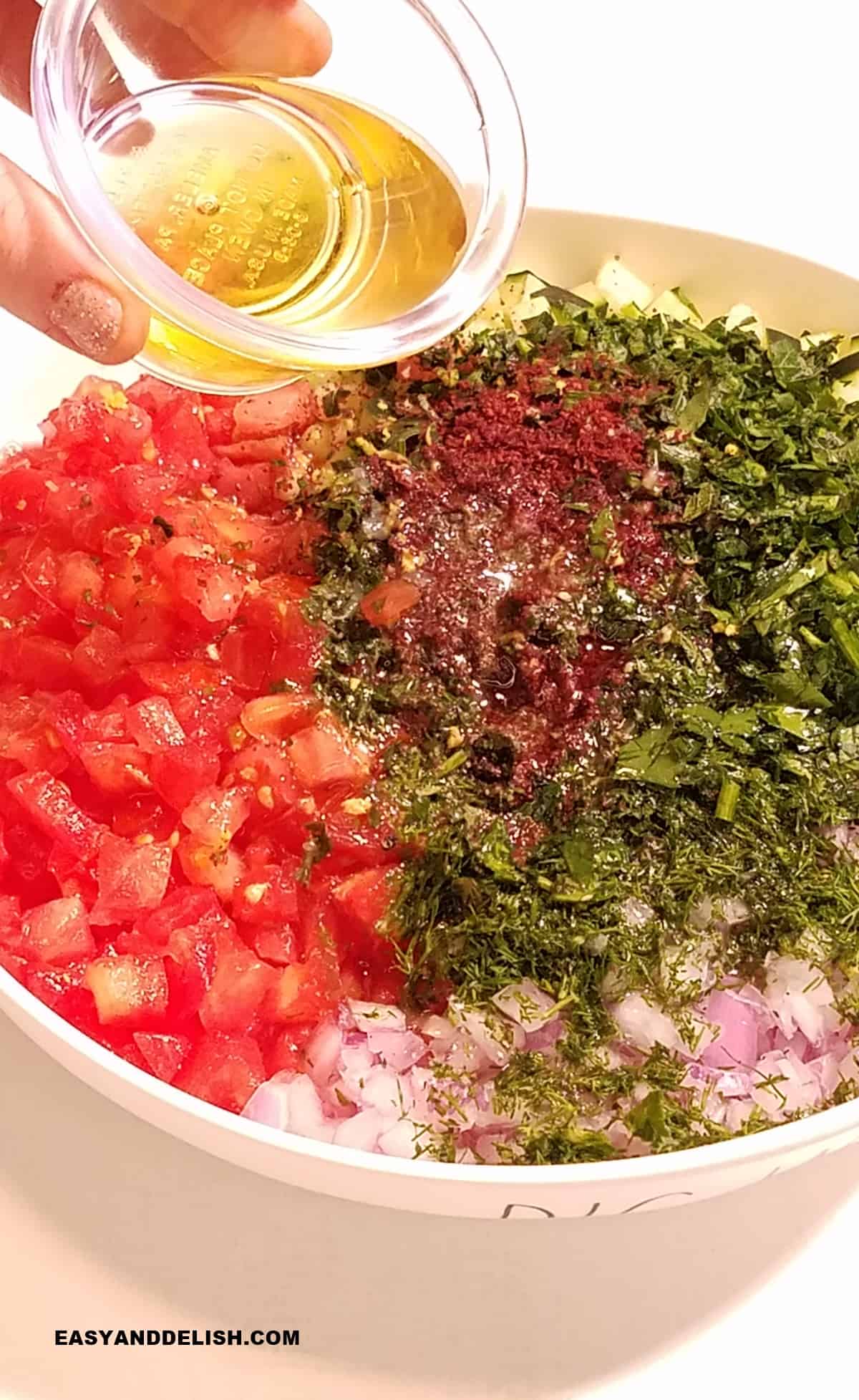
5. If you have time, cover and chill this salad in the fridge for 30 minutes to 1 hour for the best flavor.
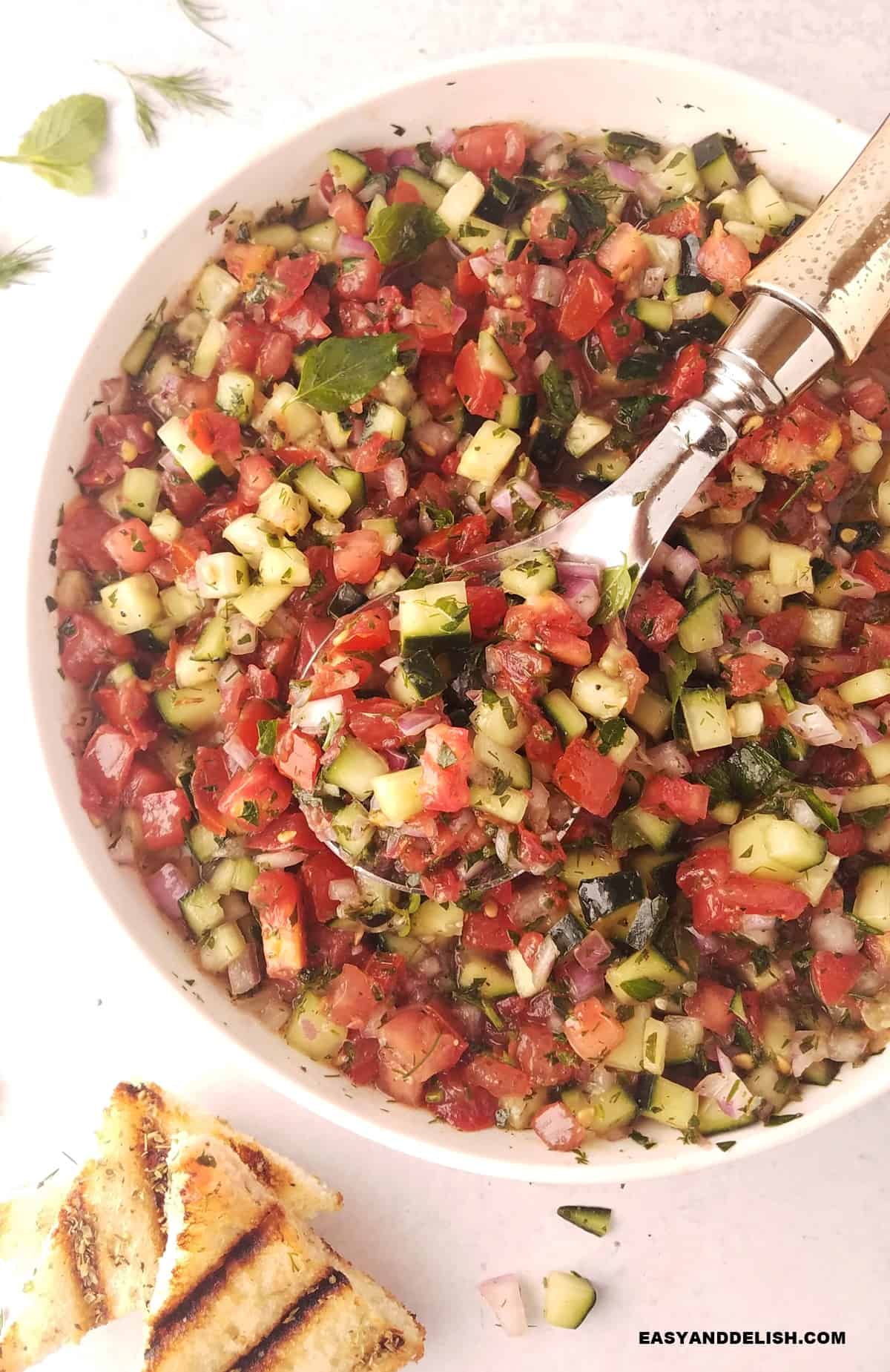
Useful tips for making Persian cucumber salad
- Use fresh ingredients: Choose fresh, quality vegetables to achieve the ideal flavor and texture in your Shirazi salad.
- Chop evenly: Don’t forget to chop the vegetables into small, bite-sized pieces. This allows for an even distribution of seasonings, and it also increases the absorption of flavors into the vegetables.
- Seed the tomatoes: To avoid a watery salad, it’s essential to seed the tomatoes.
- Keep it crunchy: For a crunchier texture, hold off on adding the lime juice and olive oil dressing until just before serving.
- Let it marinate: If you prefer a juicier texture and more flavor development, toss the salad with the dressing and let it chill for at least 30 minutes.
- Toss gently: Toss the salad gently to avoid bruising the chopped vegetables.
- Evenly coat: Be careful not to overdress the salad to prevent it from turning soggy.
- Add sumac: Although optional in this Persian cucumber salad recipe, I highly recommend incorporating sumac for added depth, complexity, and tang.
What to serve with this Iranian salad
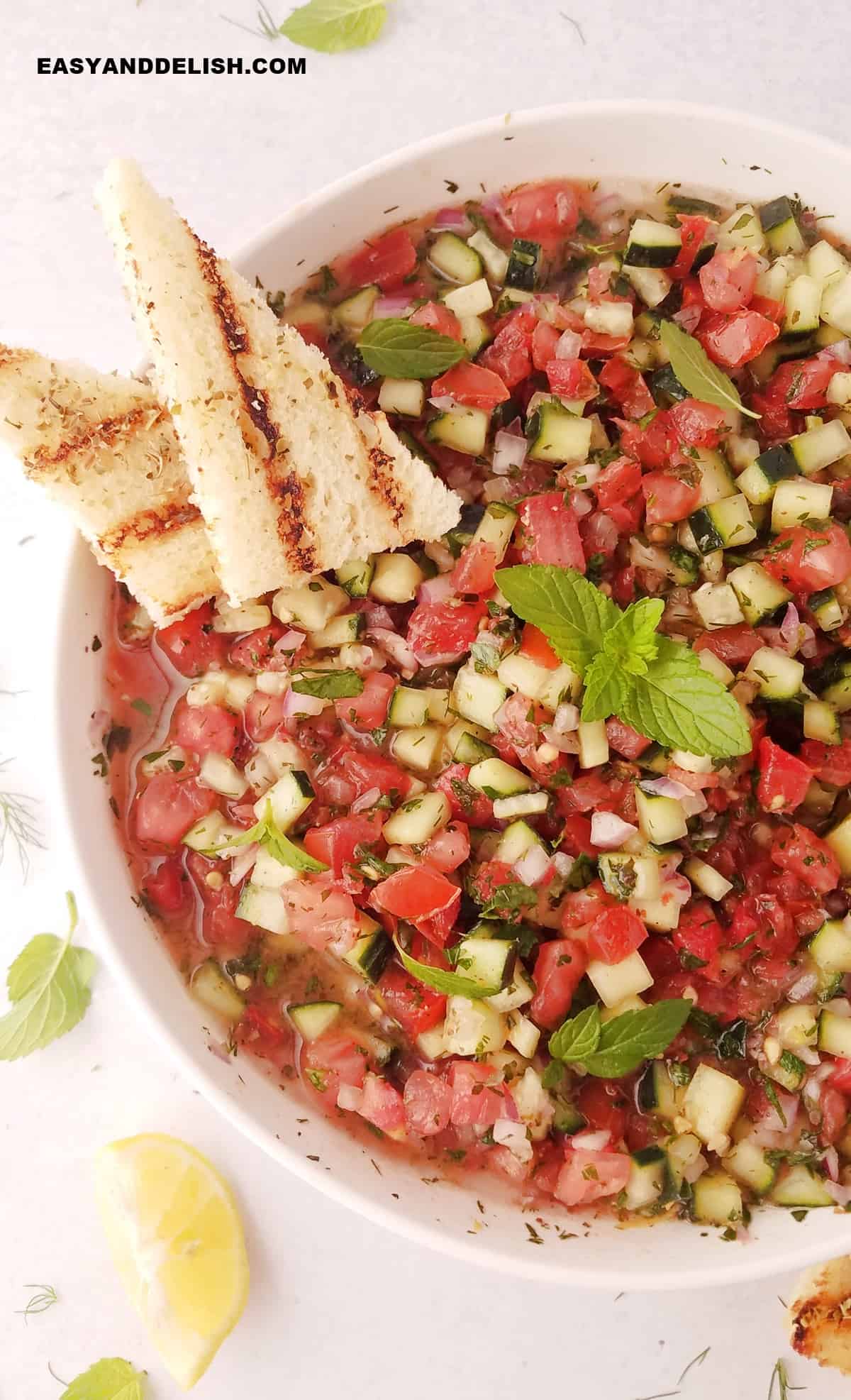
To make a complete meal, serve this Iranian salad with sides and mains like these:
- Grilled chicken legs or grilled salmon
- Kabobs
- Flatbreads such as sangak or pita bread
- Persian rice such as basmati rice
- Falafel
- Gyro meat
- Mediterranean burger
- Keto Hummus or other dips such as whipped feta dip.
FAQ’s
What are some related chopped salads from around the world?
Many recipes around the world are similar to Shirazi salad. Here’s a brief outline of some of the most popular:
- Afghan salad: Hailing from Afghanistan, this salad is similar to Shirazi salad, but it often includes cilantro and chili peppers for a slightly spicy kick.
- Arab salad (Salatat al-Arab): Many Arabian countries serve this salad, which includes finely chopped cucumber, tomato, onion, and parsley. It’s usually tossed in a sumac-infused olive oil and lemon juice dressing.
- Pico de gallo: This Mexican salsa is made with tomatoes, onions, jalapeños, cilantro, and lime juice. It is mainly used as a garnish or condiment rather than a standalone salad.
- Çoban salatası (Shepherd's salad): This Turkish recipe is similar to Shirazi salad but often includes green peppers and feta cheese. It’s seasoned with olive oil, lemon juice, and pomegranate molasses.
- Israeli Salad: Made with finely diced cucumber, tomato, onion, and bell pepper, and dressed with olive oil, lemon juice, and za'atar seasoning.
- Kachumbari: Popular in Kenya and Tanzania, kachumbari includes thinly sliced cucumber, tomato, onion, and chili peppers. It’s dressed with lime juice (and sometimes avocado).
- Serbian Salad (Српска салата/Srpska salata): Similar to Shirazi salad, Serbian salad also includes bell peppers and sirene cheese. Additionally, the dressing is made from sunflower or olive oil, vinegar, and salt.
Do you need to peel Persian cucumbers?
No, the skin on Persian cucumbers is thin, tender, and easy to eat. There is no need to peel it off for Iranian salad unless you have specific dietary restrictions.
Is Shirazi salad healthy?
Absolutely! Shirazi salad is a very healthy dish since it’s made from fresh vegetables, herbs, and a light dressing. It is low in calories yet high in vitamins and minerals.
What are the differences between Persian cucumber salad recipes and Asian cucumber salads?
While Persian cucumber salad recipes, like Shirazi salad, focus on fresh herbs and citrus-based dressings, Asian cucumber salads typically incorporate vinegar-based dressings and different spicy or sweet elements. Here is a quick outline of some popular options:
- Persian cucumber salad (Shirazi salad) is fresh and tangy with a simple dressing of olive oil, lemon juice, salt, and pepper.
- Japanese salad (Sunomono) is sweet, tangy, and salty from rice vinegar, soy, and sugar.
- Chinese salads are spicy and tangy, often dressed with soy sauce, rice vinegar, and chili flakes.
- Thai salad (Som Tum) has a balance of spicy, sweet, tangy, and salty flavors from lime juice, fish sauce, and chilies.
- Indian (Kachumber) is fresh, tangy, and mildly spiced. It’s tossed with lime juice, salt, and chaat masala or cumin powder.
Is Salad-e Shirazi Mediterranean?
While Salad-e Shirazi shares some similarities with Mediterranean salads, it is specifically a Persian or Iranian dish with its own unique combination of flavors and ingredients.
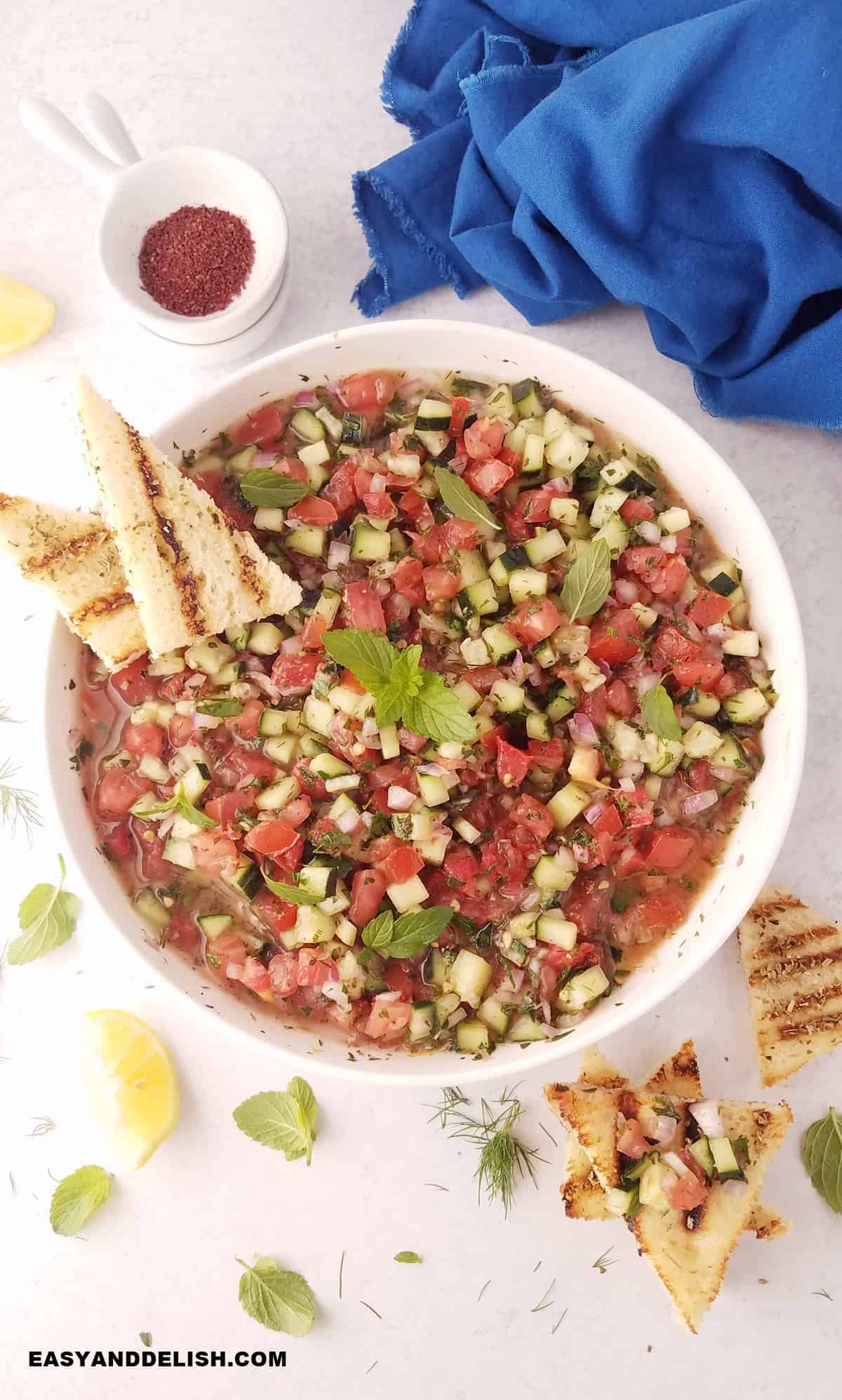
Can you make Shirazi salad ahead?
Yes, you can make Shirazi salad ahead of time. It’s best to let it chill for at least 30 minutes before serving to allow the flavors to meld together, so preparing it in advance is a great option.
Can I use dried herbs instead of fresh ones?
Fresh herbs are preferred for their vibrant flavor. If you don't have them available, you can try dried ones instead, but use a smaller amount as dried herbs are more potent.
Is Shirazi salad gluten-free?
Yes, this Shirazi salad recipe is naturally gluten-free, making it an excellent choice for those with gluten sensitivities. However, I always suggest checking each store-bought ingredient for any gluten-containing additives.
What’s sumac?
It is a deep red spice that comes from sumac berries, being often used in Persian and Mediterranean cuisines because it adds depth and a tang to any dish.
Storage
If you have leftover Shirazi salad, follow these storage tips to make the most out of your meal:
- Fridge: Store this Shirazi salad recipe in an airtight container for up to 3 days in the refrigerator.
- Freezer: Persian cucumber salad isn’t meant to be frozen since the vegetables will become mushy once thawed.
Variations
- Protein: Include grilled chicken, fish, or tofu to create a more complete meal.
- Spice: Add some finely chopped jalapeños or chili flakes for a spicy kick.
- Grains: For a more filling option, Incorporate cooked quinoa or rice into the salad.
- Cheese: Include crumbled feta cheese or goat cheese for a Mediterranean touch.
- Olives: Mix in Kalamata or green olives to add a salty, briny flavor.
- Avocado: Include diced avocado for a creamy texture and healthy fats.
- Nuts or seeds: Sprinkle some toasted nuts on top, like almonds, walnuts, or pistachios. You can even try sesame seeds or pumpkin seeds.
Other salad recipes to enjoy
- Butternut squash salad
- Vegan raw salad
- Shaved Brussels sprout salad
- Antipasto salad
- White bean salad
- Caprese pasta salad
- Beet goat cheese salad
- Berry salad
- Cowboy caviar
- Heart of Palm salad skewers
- Fresh zucchini salad
- Healthy potato salad
- Cucumber chickpea salad
PIN & ENJOY!
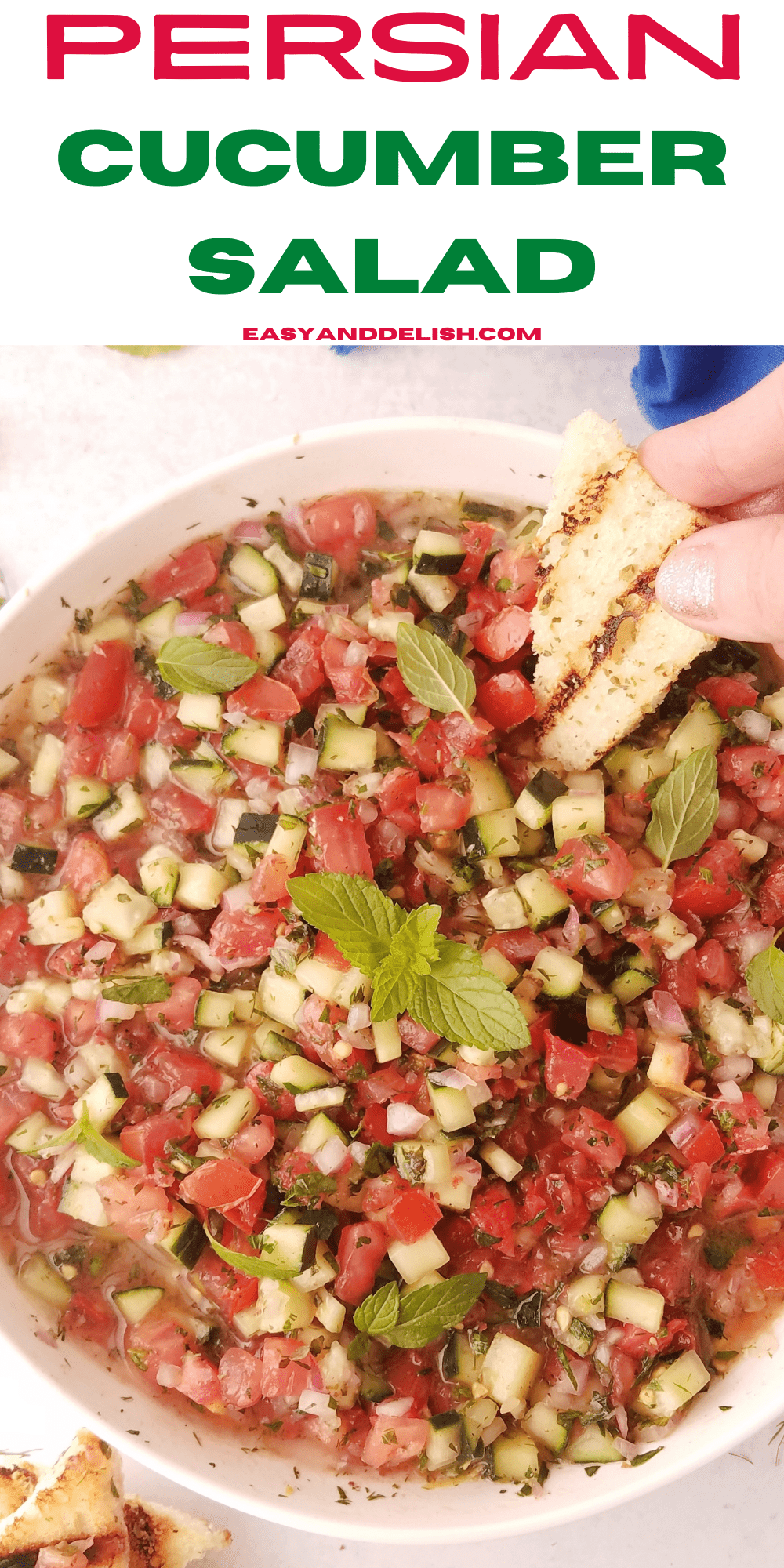
Shirazi Salad
Equipment
- 1 Chef's knife
- 1 cutting board
- 1 large bowl
Ingredients
- 4 Roma tomatoes small diced (if not removing the seeds, place the chunks in a colander for about 5 minutes to release excess juices. But if you have 5- minutes to spare, I recommend you remove the seeds!) - You can use cherry tomatoes as an alternative but make sure to small-dice them.
- 1 English cucumber or 4 small Persian cucumbers, small diced (no need to peel)- Field cucumbers will work in a pinch, but make sure to peel and seed them.
- ½ cup finely chopped red onions or yellow onions if you prefer
- 3 tablespoon EACH chopped fresh parsley, mint, and dill Fresh cilantro can be used as well.
- Salt and pepper to taste
- 1 teaspoon sumac or more to taste (optional) - Alternatively, use lemon zest, lemon pepper, coriander, or za’atar.
- 4 tablespoon fresh lemon juice OR lime juice can be used as a substitute and gives this salad a better tangy taste.
- 3 tablespoon extra virgin olive oil You can also try avocado oil or another mild-flavored oil.
Instructions
- Prep all the ingredients! Then, place the diced tomatoes, cucumbers, and onions into a large bowl.
- Next, add the fresh herbs, and a good pinch of salt and pepper to the veggie mixture. Add sumac and then lime juice and EVOO, tossing everything together to combine. TIP: For a crunchier texture, only add lime juice and EVOO about 15 minutes before serving the salad.
- If you have time, cover and chill this salad in the fridge for 30 minutes to 1 hour for the best flavor.
Recipe Video

Recipe Notes
- Fridge: Store this Shirazi salad recipe in an airtight container for up to 3 days in the refrigerator.
- Freezer: Persian cucumber salad isn’t meant to be frozen since the vegetables will become mushy once thawed.
Nutrition
** Nutrition labels on easyanddelish.com are for educational purposes only. This info is provided as a courtesy and is only an estimate, since the nutrition content of recipes can vary based on ingredient brand or source, portion sizes, recipe changes/variations, and other factors. We suggest making your own calculations using your preferred calculator, based on which ingredients you use, or consulting with a registered dietitian to determine nutritional values more precisely.
Please note that health-focused and diet information provided on easyanddelish.com is for educational purposes and does not constitute medical advice, nor is it intended to diagnose, treat, cure, or prevent disease. Consult with your doctor or other qualified health professional prior to initiating any significant change in your diet or exercise regimen, or for any other issue necessitating medical advice.



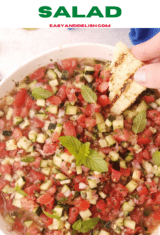
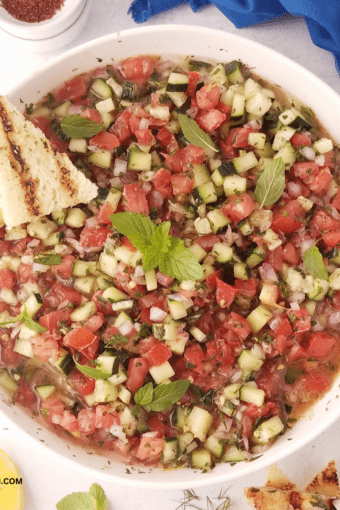
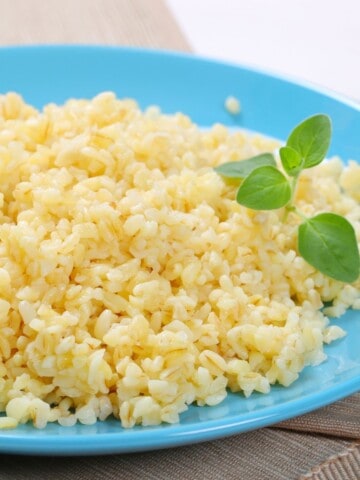


Nina says
I served this Shirazi salad as a dip with low-carb pita chips for movie night and my husband loved it. We are on a keto diet and always on the looking for easy low-carb recipes.